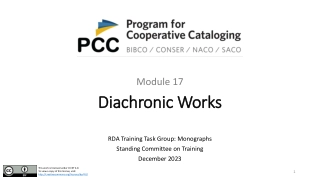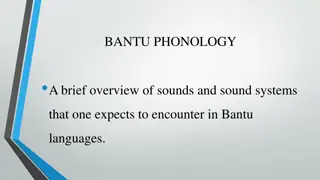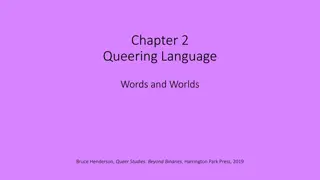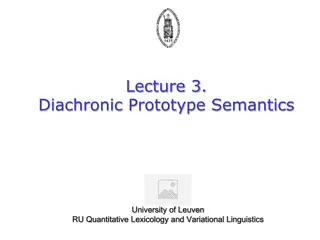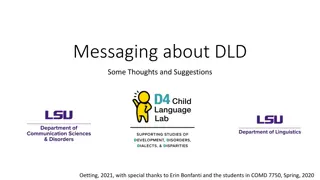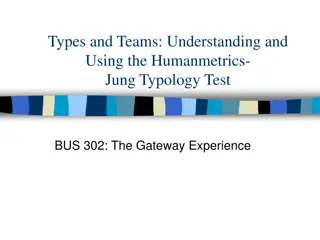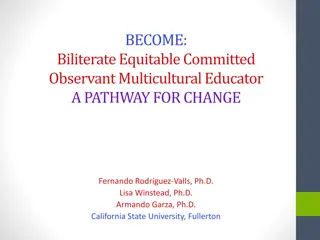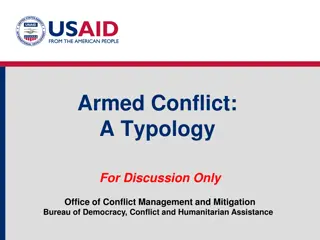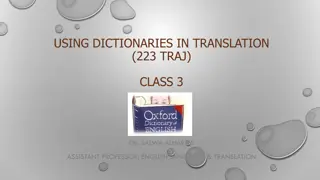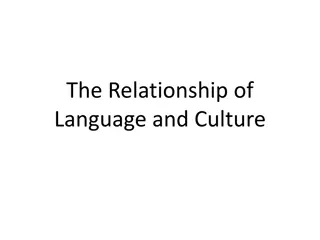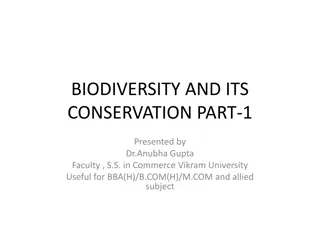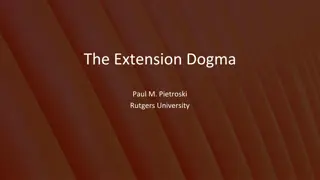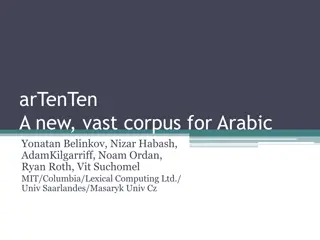Exploring Diachronic Typology and Linguistic Diversity
Delve into the fascinating realm of diachronic typology and linguistic properties across languages in time and space. Uncover the distribution of linguistic features, the past tense in various languages, and the underlying constraints shaping language structures. Discover the intricate interactions between cognition, physiology, language change, and Greenbergian typology.
Download Presentation

Please find below an Image/Link to download the presentation.
The content on the website is provided AS IS for your information and personal use only. It may not be sold, licensed, or shared on other websites without obtaining consent from the author. Download presentation by click this link. If you encounter any issues during the download, it is possible that the publisher has removed the file from their server.
E N D
Presentation Transcript
A brief overview of diachronic typology Eitan Grossman (Hebrew University of Jerusalem) Academia Grammaticorum Salensis 24-30 July 2022
Some questions Why are linguistic properties distributed the way they are across languages in time and space (Greenberg 1978, Nichols 1992, Bickel 2007)? Why are some linguistic properties common, and others rare (Greenberg 1978, Harris 2008, Wohlgemuth & Cysouw 2009)? It is probably easier to explain the universal absence or the universal presence of a property, but such absolute universals are often rare, or are trivial or even simply definitional criteria of language, and often have more to do with communication than with linguistic structure.
The past tense in a sample of the world The past tense in a sample of the world s languages ( (Dahl & Dahl & Velupillai Velupillai 2013 s languages 2013) )
Sources of Sources of crosslinguistic crosslinguistic frequency asymmetries? frequency asymmetries? Constraints on processing Constraints on memory Constraints on learnability Constraints on articulation Constraints on perception Genetically-determined Universal Grammar What about constraints on social interaction processing? memory? learnability? articulation? perception? Universal Grammar? social interaction?
But how do these constraints translate into language structure? Is there a direct structures, or is this connection mediated somehow, and if so, by what? direct mapping between cognition or physiology and language
An underappreciated aspect of Greenbergian typology What mediates between cognition/physiology and language structures is language change language change.
Greenberg (1978) If a particular phenomenon can arise very frequently and is highly stable once it occurs, it should be universal or near universal ( ). If it tends to come into existence often and in various ways, but its stability is low, it should be found fairly often but distributed relatively evenly among genetic linguistic stocks. [ ] If a particular property rarely arises but is highly stable when it arises, it should be fairly frequent on a global scale but be largely confined to a few genetic stocks. If it occurs only rarely and is unstable when it occurs, it should be highly infrequent or non-existent or sporadic in its genealogical and genetic distribution (Greenberg 1978: 76).
Diachronic typology Diachronic typology is the typological study of processes of language change and their causes.
Diachronic typology Cross-linguistically recurrent categories are generally assumed to be the result of cross-linguistically recurrent patterns of grammaticalization or other general and regular processes of change. Joan Bybee, William Pagliuca & Revere Perkins (1994), The Evolution of Grammar. Tense, aspect and modality in the languages of the world. Chicago.
Diachronic typology Cross-linguistically recurrent sound patterns are generally assumed to be the result of cross-linguistically recurrent patterns of sound change and retention. For example, nasal vowels are typically the result of VN sequences in which the vowel is contextually nasalized, and the nasal consonant is eventually lost. The nasality of the vowel can subsequently be lost (Greenberg 1969).
Diachronic typology More broadly, synchronic distributions are the result of biases in language change, which are in turn rooted in a variety of factors, including usage biases. Joseph Greenberg Talmy Giv n Charles Ferguson John Ohala Joan Bybee Juliette Blevins Spike Gildea Andrea Sans Sonia Cristofaro
Diachronic typology More broadly, synchronic distributions are the result of biases in language change, which are in turn rooted in a variety of factors, including usage biases. For Greenberg (1969, 1978) and Bybee (2006 and elsewhere), diachronic universals are more robust than synchronic ones synchronic states are epiphenomenal. For Blevins (2004), a principled diachronic explanation makes a synchronic explanation redundant. Similar ideas in Cristofaro (2017, 2019), who argues for a source-oriented approach to synchronic distributions.
Focusing the question Why do some categories become conventionalized (grammaticalized or phonemicized) in many but not all languages?
A possible answer From the point of view of diachronic typology, cross-linguistically common categories are common because they involve (Grossman 2016, Grossman et al 2018, Grossman & Polis 2018)): 1. 1. TYPE TYPE: the type of change is common (vs. rare types of change) 2. 2. PATH PATH: multiple pathways of change that converge (vs. a single pathway) 3. 3. STAGE STAGE: one-step or simple pathways of development (vs. many-step or complex pathways) 4. 4. SOURCE SOURCE: common source constructions vs. rare source constructions 5. 5. STABILITY STABILITY: once grammaticalized, the category type tends to be stable 6. 6. DIFFUSABILITY DIFFUSABILITY: the category spreads easily via language contact.
Mutatis mutandis The more that these factors converge, the more common a particular category will be, cross-linguistically. And cross-linguistic rarities can be explained by the convergence of these factors, but in reverse.
Some brief examples from phonology Northwest Mekeo (Austronesian) lacks any coronal segments, the result of 3 distinct processes of change, some of which are rare. However, the language is now developing allophonic coronals, so the state of having no coronals seems to be inherently unstable (Blevins 2009). Aspirated fricatives are very rare (Jacques 2011). Interestingly, they can develop along multiple pathways from common sources, but they seem to be perceptually similar to other sounds, which leads them to quickly merge. Similarly, Nikolaev & Grossman (2018) show that affricate-dense inventories develop from common sources through common types of change, but they are unstable unless supported by language contact, i.e., they are lost when isolated areally.
Some brief examples from phonology On the other hand, Bybee & Easterday (2022) show that while ejectives can develop from common source patterns in relatively simple processes (like the fusion of a voiceless obstruent with a following glottal stop), there is little evidence for such changes to be the source of most ejectives in the world s languages. Ejectives may simply be very old and very stable in the parts of the world where they are documented.
Summary In contrast to traditional (and some contemporary) views, the cross- linguistic frequency or rarity of a category is not simple a reflection of cognitive, physical, or social biases or constraints. Rather, cross-linguistic frequency distributions are the result of different factors, which may act independently and interact.
Summary 1. 1. TYPE TYPE: the type of change is common (vs. rare types of change) 2. 2. PATH PATH: multiple pathways of change that converge (vs. a single pathway) 3. 3. STAGE STAGE: one-step or simple pathways of development (vs. many-step or complex pathways) 4. 4. SOURCE SOURCE: common source constructions vs. rare source constructions 5. 5. STABILITY STABILITY: once grammaticalized, the category type tends to be stable 6. 6. DIFFUSABILITY DIFFUSABILITY: the category spreads easily via language contact.
Universally dispreferred structures through change The diachrony of affix ordering in Egyptian-Coptic Eitan Grossman (Hebrew University of Jerusalem) & St phane Polis (F.R.S.-FNRS) Academia Grammaticorum Salensis 24-30 July 2022
Outline of the talk Introduction Introduction Observation Observation. . A worldwide preference for suffixes as opposed to affixes Argument Argument. Rare or universally dispreferred structures can and do arise as the result of regular language change, given the right background structures as the particular ecology in which change takes place Case Case- -study: study: Egyptian-Coptic (Afroasiatic) Long-term diachronic macro-change from mixed suffixing-prefixing to an overwhelming preference for prefixing Conclusions Conclusions Each of the micro-changes implicated in this macro-change are better understood in terms of changes at the level of individual constructions, via grammaticalization, rather than in terms of a broad Sapirian drift. These micro-changes take place at different times and have different rates E. Grossman (HUJi) & St. Polis (F.R.S.-FNRS) 22
A worldwide preference for suffixes as opposed to prefixes E. Grossman (HUJi) & St. Polis (F.R.S.-FNRS) 23
Preference for suffixes There is a worldwide preference for suffixes as opposed to prefixes in a proportion of about 3 to 1 in the languages of the world (Bybee et al. 1990, Cysouw 2009, Greenberg 1957, Hall 1998, Hawkins & Cutler 1988, Himmelmann 2014, Sapir 1921, and more) E. Grossman (HUJi) & St. Polis (F.R.S.-FNRS) 24
Preference for suffixes There is a worldwide preference for suffixes as opposed to prefixes in a proportion of about 3 to 1 in the languages of the world (Bybee et al. 1990, Cysouw 2009, Greenberg 1957, Hall 1998, Hawkins & Cutler 1988, Himmelmann 2014, Sapir 1921, and more) Two distinct universal preferences (Himmelmann 2014): grammatical morphemes have a significant tendency (a) to be postposed and (b) to be bound, i.e., suffixes Table 1. The suffixing preference in verbal grammatical elements from 71 languages (Himmelmann 2014, from the database of Bybee et al. 1990: 5) E. Grossman (HUJi) & St. Polis (F.R.S.-FNRS) 25
Preference for suffixes Possible explanations . some form of Universal Grammar language contact (but see Seifart 2015) processing or some other cognitive mechanism (Cutler, Hawkins & Gillingan 1986, Caballero et al. 2008) a correlation with the linear order of major constituents (Jacques 2013) a world-wide retention from Proto-World (cf. Gell-Mann & Ruhlen 2011) processes of language change, e.g., grammaticalization (Giv n 1971, Bybee 1985, Bybee et. al 1990), perhaps due to online usage factors (Hall 1988, Himmelmann 2014) E. Grossman (HUJi) & St. Polis (F.R.S.-FNRS) 26
Preference for suffixes Explanations provided (so far) it does not seem to be a fruitful approach to consider the suffixation preference as a monolithic observation to be explained by one overarching theory of linguistic affixation (Cysouw 2003). E. Grossman (HUJi) & St. Polis (F.R.S.-FNRS) 27
Preference for suffixes Explanations provided (so far) it does not seem to be a fruitful approach to consider the suffixation preference as a monolithic observation to be explained by one overarching theory of linguistic affixation (Cysouw 2003). Macro-characteristics of individual languages (e.g., Nichols 1986, Haspelmath et al. 2014) result from generalizations made over individual constructions E. Grossman (HUJi) & St. Polis (F.R.S.-FNRS) 28
Preference for suffixes This is captured by Dryer s (2013) method for comparing the degree to which languages are characterized by a preference for prefixing, suffixing, or neither. Table 2. Types of inflexional affixes (Dryer 2013) E. Grossman (HUJi) & St. Polis (F.R.S.-FNRS) 29
Preference for suffixes Following Dryer (2013), a language receives a single point for prefixing or suffixing if it is predominantly prefixing or suffixing for a given parameter, half a point for each if it has both prefixing and suffixing, with neither deemed dominant no point when there is no affixing for a given parameter The first three parameters (case affixes on nouns, subject and tense-aspect affixes in verbs) are deemed especially important: their score is doubled E. Grossman (HUJi) & St. Polis (F.R.S.-FNRS) 30
Preference for suffixes Table 3. Suffixing vs Prefixing in Inflectional Morphology (Dryer 2003) E. Grossman (HUJi) & St. Polis (F.R.S.-FNRS) 31
Preference for suffixes Table 3. Suffixing vs Prefixing in Inflectional Morphology (Dryer 2003) E. Grossman (HUJi) & St. Polis (F.R.S.-FNRS) 32
Interim summary As far as inflectional morphemes are concerned, typology corroborates a worldwide preference for postposed and suffixed elements. Languages that are predominantly prefixing are rare.
Ancient Egyptian-Coptic Long-term changes towards a predominantly prefixing language E. Grossman (HUJi) & St. Polis (F.R.S.-FNRS) 34
Ancient Egyptian-Coptic Background information An independent branch of the Afroasiatic phylum or quasi-stock First attested at the end of the fourth millenium BCE, and documented continually until sometime in the 13th or 14th century CE, when all of its speakers shifted to Arabic E. Grossman (HUJi) & St. Polis (F.R.S.-FNRS) 35
Ancient Egyptian-Coptic Background information Standardly divided into five stages and and two macro-phases Table 4. Stages of Egyptian-Coptic (as discussed here) E. Grossman (HUJi) & St. Polis (F.R.S.-FNRS) 36
Ancient Egyptian-Coptic Background information Standardly divided into five stages and and two macro-phases Table 4. Stages of Egyptian-Coptic (as discussed here) E. Grossman (HUJi) & St. Polis (F.R.S.-FNRS) 37
Ancient Egyptian-Coptic Background information Coptic is a predominantly prefixing language Earlier Egyptian is not: Dominant VSO order of major constituents A small number (1-3) of postposed or suffixed inflectional morphemes on nouns and verbs A diachronic trend from synthetic to analytic to agglutination and polysynthesis (anasynthesis, Haspelmath 2011) A diachronic trend towards prefixed grammatical elements E. Grossman (HUJi) & St. Polis (F.R.S.-FNRS) 38
Ancient Egyptian-Coptic Table 5. Calculation of the affixing index for Coptic 39
Ancient Egyptian-Coptic Table 5. Calculation of the affixing index for Coptic 40
Ancient Egyptian-Coptic Table 5. Calculation of the affixing index for Coptic 41
Ancient Egyptian-Coptic Background information Coptic is a predominantly prefixing language With its extremely high prefixing preference (12/13), Coptic belongs to the rare 6% or so of languages that are predominantly prefixing. Moreover, it has a higher prefixing index than any other language in Dryer s 969-language sample. (The closest competitor is Hunde [Bantu; Democratic Republic of Congo; Kahombo 1992], with a prefixing index of 9.5/13.) E. Grossman (HUJi) & St. Polis (F.R.S.-FNRS) 42
Ancient Egyptian-Coptic Background information Coptic is a predominantly prefixing language With its extremely high prefixing preference (12/13), Coptic belongs to the rare 6% or so of languages that are predominantly prefixing. Moreover, it has a higher prefixing index than any other language in Dryer s 969-language sample. (The closest competitor is Hunde [Bantu; Democratic Republic of Congo; Kahombo 1992], with a prefixing index of 9.5/13.) Coptic is an areal outlier While predominantly prefixing languages are relatively common in Mesoamerica and in Africa, within Africa it is only in western and southern sub- Saharan Africa that predominant prefixing is common E. Grossman (HUJi) & St. Polis (F.R.S.-FNRS) 43
The diachrony of affix ordering Methodology For diachronic purposes, a modified form of Dryer s typology is useful. Rather than limiting the score to 0 for no affix, 1 for either suffixing or prefixing, and 0.5 for both prefixing and affixing, we suggest using two scales, both of which admit a more fine-grained analysis E. Grossman (HUJi) & St. Polis (F.R.S.-FNRS) 46
The diachrony of affix ordering Methodology Table 6. A finer-grained index for affixing 47
The diachrony of affix ordering Parameter 1 Case affixes on nouns Coptic Prefixed case markers (on postverbal noun phrases in S, A, or P role) E. Grossman (HUJi) & St. Polis (F.R.S.-FNRS) 48
The diachrony of affix ordering Parameter 1 Case affixes on nouns Previous stages Previous stages Coptic Coptic Prefixed case markers (on postverbal noun phrases in S, A, or P role) E. Grossman (HUJi) & St. Polis (F.R.S.-FNRS) 49
The diachrony of affix ordering Parameter 1 Case affixes on nouns Previous stages Previous stages Coptic Coptic Prefixed case markers (on postverbal noun phrases in S, A, or P role) Type of change: Type of change: ( (secondary) marker, and from antitopic marker to nominative marker) secondary) grammaticalization grammaticalization (from preposition to accusative case E. Grossman (HUJi) & St. Polis (F.R.S.-FNRS) 50


